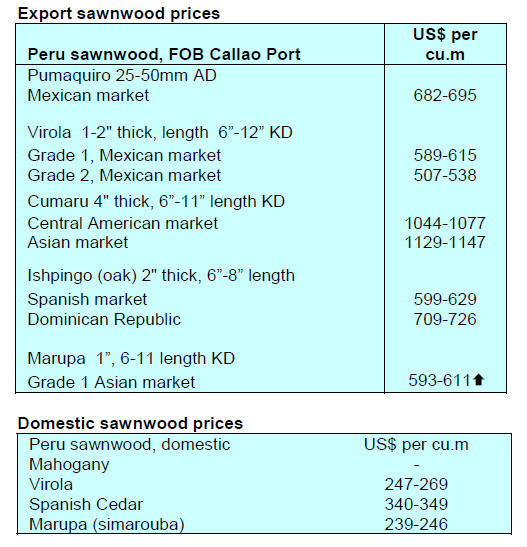4.
INDONESIA
APHI Calls on EU to Promote SVLK
The Association of Indonesian Forest Concession Holders
(APHI) has called on the European Union to jointly
promote the Legality and Sustainability Verification
System (SVLK) to further strengthen Indonesia’s efforts to
improve forest governance in support of climate change
action.
Chairman of APHI, Indroyono Soesilo said that Indonesia
and the EU have had a Voluntary Partnership Agreement
(VPA) for Forest Law Enforcement, Governance and
Trade (FLEGT-VPA) since 2013. He commented that
under the Agreement the EU has an obligation to promote
FLEGT licenses in accordance with article 13 of the
FLEGT VPA.
Indroyono said during a meeting with the EU Ambassador
to Indonesia at the APHI office that Article 13 must be
implemented to support FLEGT licensing. Indroyono said,
despite being one of the main markets, exports of
Indonesian wood products to the EU are still relatively
small and that Indonesia needs support to expand its
market share.
In response the Ambassador explained that EU consumers’
awareness of green products that are environmentally
friendly is getting stronger, therefore fulfilling the
elements of legality and sustainability is important.
Regarding Article 13 the Ambassador said this could be
one of the points of discussion at the high-level meeting of
the EU and Indonesia later in the year.
See:
https://forestinsights.id/2022/07/04/aphi-calls-on-eu-topromote-svlk-to-strengthen-indonesian-forest-governance/
Forestry sector should be contributing more to GDP
The contribution of the forestry and wood processing
sectors to national gross domestic product (GDP) was only
Rp112 trillion or 0.66% according to the Minister of
Finance, Sri Mulyani Indrawati.
She added that the government needs to make
improvements since Indonesia is home to vast tropical
forests so the sector should be contributing significantly
more.
See:
https://www.kemenkeu.go.id/publikasi/berita/menkeuungkap-perlunya-tingkatkan-kontribusi-sektor-kehutanan/
and
https://economy.okezone.com/read/2022/06/28/320/2619901/srimulyani-ungkap-kontribusi-hutan-ke-pnbp-hanya-rp5-6-triliun?page=2
Realising a ‘multi-business’ forestry sector requires
investment
Development of a multi-business forestry model is a
business opportunity that can help address climate change
as well as improving the welfare of the people living close
to the forest.
The Deputy Chairman of the Chamber of Commerce and
Industry (Kadin) for Environment and Forestry, Silverius
Oscar Unggul, said that Kadin and APHI continue to look
for the marketing models and the products and services to
be developed in multi business forestry operations.
The Deputy Chairman of APHI, Soewarso, said the
challenge in the plantation forestry business is the long
investment period and if a viable multi-business model can
be found prospects will be more attractive.
Soewarso proposed that banks and financial institutions
implement innovative blended financing for wood, nontimber
forest products and carbon trading. As security
Soewarso suggested that a Certificate of Emissions
Reduction (CER) issued by an authorised institution could
be used as a guarantee to obtain financing.
See:
https://forestinsights.id/2022/07/09/implementasi-multiusaha-kehutanan-perlu-dukungan-pembiayaan/
A huge investment needed to meet forestry NDC target
The cost of reaching the Nationally Determined
Contribution (NDC) target for the forestry sector is
estimated at Rp77.82 trillion according to the Minister of
Finance, Sri Mulyani Indrawati. According to the Minister
the forestry sector could have the biggest contribution to
greenhouse gas emission reductions compared to other
sectors.
See:
https://en.antaranews.com/news/236569/need-rp7782-trillion-to-meet-forestry-ndc-target-minister
Forestry Congress reaffirms role of forestry sector in
National Development
At the opening of the 7th Indonesian Forestry Congress
themed "Managed Forests, Protected Earth and an
Empowered Nation” the Minister of Environment and
Forestry, Siti Nurbaya, called upon forestry sector
stakeholders to strengthen their commitment in
encouraging the progress in Indonesia's forestry
development and to actively participate in international
efforts to achieve sustainable development and address
climate change.
The Congress aimed to play a role in the national agenda
on climate change as formulated in the 2030 FoLU Net
Sink.
The Minister was reported as saying “In responding to
these global challenges, breakthrough steps, innovation
and collaboration are needed to accelerate the
implementation of climate change mitigation actions, as
well as optimize scientific resources in earth management
for completion and efforts for sustainability and prosperity
as a legacy for our future generations".
See:
https://www.menlhk.go.id/site/single_post/4837/kongreskehutanan-indonesia-vii-meneguhkan-kembali-pengelolaansektor-kehutanan-pada-pembangunan-bangsa
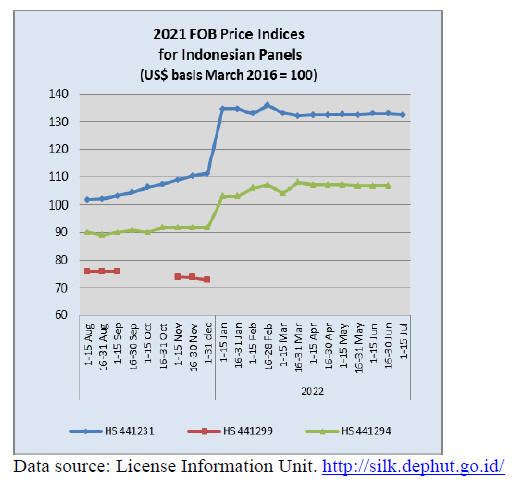
5.
MYANMAR
MTE Tender bids to be in local
currency
According to log buyers/exporters, without notice, the
Myanma Timber Enterprise (MTE) changed the currency
in which tender bids should be made from US dollars to
the local currency kyat (MMK). Millers now have to bid in
MMK.
This is a major change at MTE which has required bids in
US dollars for past decades. After the government required
conversion of incoming US dollars to MMK within one
day in April this year payments to MTE for logs had been
stalled for about three months.
It is unclear if this is a permanent change and it is too early
to say that it is the end of the US$ dominated payment
system by MTE.
The MTE is sanctioned by EU and US and is denied
international swift transfers. Although the change to MMK
is a consequence of the intensified monetary control
measures by the government by coincidence now MTE is
not recipient of US$. The earnings of hard currencies is a
main cause of sanctioned by EU and USA introduced after
the military took control in February 2021.
Yuan-denominated China border trade back to dollars
Yuan-denominated settlement in China-Myanmar border
trade hit over 500 million yuan (US$74.44 million) in the
first half of 2022 despite the closure of most border
crossings due to covid prevention and control measures.
The Myanmar government accepted the yuan as an official
settlement currency for border trade with China, its biggest
trading partner in December last year. The Global Times
reported earlier that the estimated settlement scale in the
pilot phase is about 2 billion yuan, which is equivalent to
about 30 percent of the value of bilateral border trade via
inland routes.
According to a report on a Chinese-language website in
Myanmar on July 3, the authorities in Myanmar informed
traders in Muse, one of Myanmar's main border trade
points with China, that payments should be switched back
to US dollars.
According to the media this change applies to local
enterprises but not to financial institutions which provides
the opportunity for banks to still settle the border trade in
yuan.
See:
https://www.globaltimes.cn/page/202207/1270273.shtml )
6.
INDIA
House prices down loan rates up
Housing sales have fallen by 15% in the top seven Indian
cities driven down by increased prices and rising rates for
home loans. The Mumbai Metropolitan Region (MMR)
recorded the highest sales of apartments between April
and June according to a report released by ANAROCK
Property Consultants.
Anuj Puri, Chairman of the ANAROCK Group, is quoted
in the Times of India as saying inflationary pressures on
input costs compelled developers to increase property
prices in the past few months and RBI unleashed two rate
hikes that pushed up home loan interest rates.
See:
https://realty.economictimes.indiatimes.com/news/residential/housing-sales-in-delhi-ncr-fell-19-in-apr-jun-anarock/92642941
Improving turn-around time at ports
A recent meeting of the Ministry of Ports, Shipping and
Waterways chaired by Sarbananda Sonowal, Union
Minister for Ports, Shipping and Waterways concluded
with some notable decisions. Sonowal suggested that all
ports should prepare a master plan to become Mega Ports
by 2047. The meeting also discussed the application of
automated technologies that could improve the
performance at Indian Ports.
The Minister specifically called for layover times at
india’s major ports to be reduced. He said “There should
be zero waiting time for inbound and outbound cargo”.
This will require reducing current wait time of around a
day for berthing at major ports. The media quote the
average time before a cargo ship was berthed at a major
port in 2021 was around 0.95 days.
According to official estimates the container turn-around
time at major Indian ports is about 26.5 hours. This has
come down from around 45 hours in 2013-14. Sonowal
said that a Master Plan to enable ports to identify and
resolve bottlenecks in multi-modal connectivity in vital.
See:
https://nenow.in/north-east-news/assam/sarbanandasonowal-asks-all-ports-to-prepare-master-plan-to-becomemega.html
Rupee tumbles – pain for importers
Indian importers will be feeling pain as the rupee fell to a
record low of 79.38 to the US dollar recently as news
emerged that the country's trade deficit hit an all-time high
in June due mainly to the surge in crude oil
and coal imports. The Reserve Bank of India (RBI) has
intervened but has not been able to stem the sharp decline.
The government has introduced a tax on gold imports and
the RBI has intervened in the foreign exchange markets by
selling dollars. The central bank also announced a series of
measures to increase foreign exchange inflows to boost the
rupee.
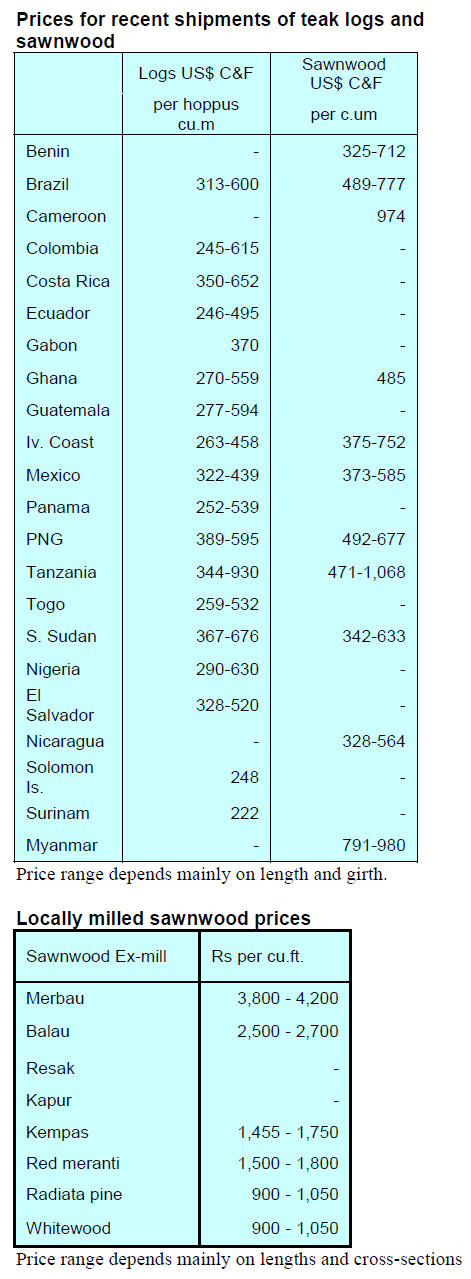
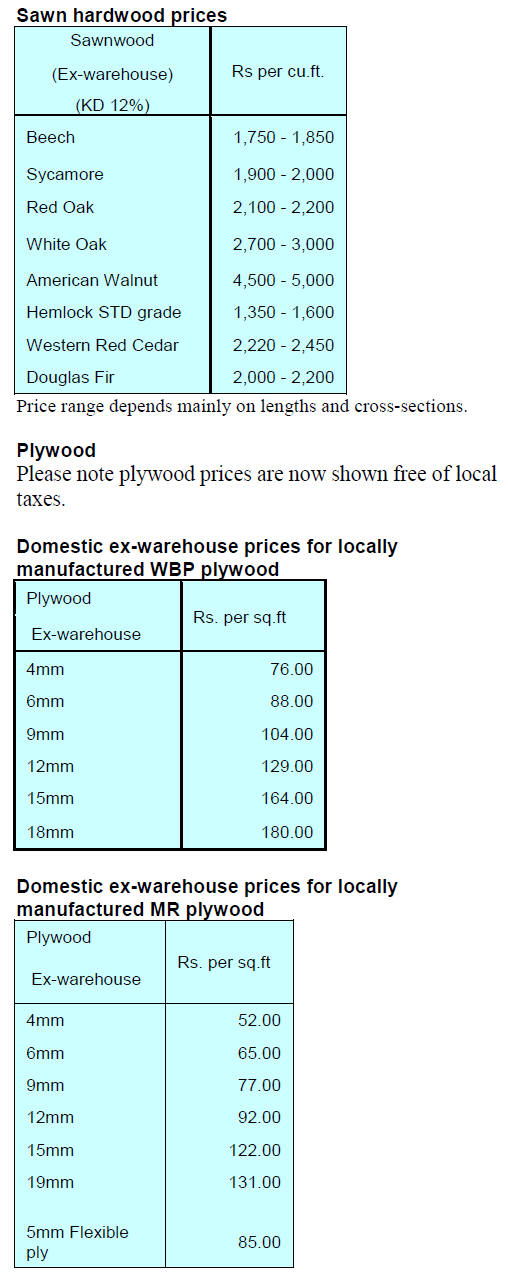
7.
VIETNAM
Vietnam: Wood and wood product (W&WP) trade
highlights
According to the Vietnam General Department of
Customs, the W&WP exports to the US in June 2022 were
estimated at US$826.3 million, down 19% compared to
June 2021. In the first half of 2022 exports of W&WPs to
the US totaled US$4.92 billion down 2.5% compared to
the same period in 2021.
Vietnam's exports of office furniture in June 2022 reached
US$30.3 million, down 32% compared to June 2021. In
general, in the first 5 months of 2022 exports of office
furniture were valued at US$156.8 million, down 27%
compared to the same period in 2021.
Imports of raw wood in June 2022 have been estimated at
602,000 cu.m, worth US$237.8 million, up 4.6% in
volume and 3% in value.
In June Vietnam's exports of timber and wood products
decreased due to the impact of high inflation in export
markets according to the Ministry of Industry and Trade.
In the first six months of this year the value of wood and
wood product exports rose 2.8% year on year to US$8.5
billion. But exports of wood products declined almost 5%
to US$6 billion.
Wooden furniture was the main export item but exports
earning dropped as the economies in importing countries
suffered rising inflation and declining consumer
confidence. High US inflation has caused low- and
middle-income groups to tighten their spending, creating a
significant impact on Vietnam's wood product exports.
In addition, the decline in export earnings in the first half
of this year were affected by very high logistics costs.
Exporters say that in some cases the value of wood
products in a containers shipped to the US is lower than
the shipping cost. Because of high shipping costs some US
buyers are switching to suppliers in countries that are
closer such as Mexico to keep shipping costs down.
Vietnam wood product manufacturers have started to
report weaker order book positions due to reduced orders
from the US as well as South Korea and the EU.
The declining orders in the first half of 2022 has worried
the wood industry as they fear they may not achieve the
export growth target this year. For 2022 export turnover
growth for wood and wood products is forecasted to reach
only 5-7% in contrast to the 9% growth in 2021.
In the light of high inflation that is not shown any signs of
cooling globally businesses are also reviewing orders to
achieve the most efficiency in production and management
in order to keep their customers.
Do Xuan Lap, Chairman of the Vietnam Timber and
Forest Products Association, said the issue for the wood
industry today is that Vietnam needs to develop highquality
domestic wood raw material sources to maintain its
competitive advantage.
See:
https://en.vietnamplus.vn/vietnams-wood-exports-decreaseas-inflation-increases/233562.vnp
A special contribution from Dr. Hoang Lien Son,
Director of the Forest Economics Research Centre,
Vietnamese Academy of Forest Science
Current Situation of Vietnam’s Timber Imports and
Policy Solutions - Towards Timber Legality Assurance
Over the last two decades Vietnam has been emerging as a
top producer of wood and wood products (W&WP). At
present, W&WP from Vietnam are shipped out to over
140 overseas markets, and Vietnamese wood operators
must comply with increasing requirements on timber
legality assurance imposed by importers.
The US Lacey Act, the Korea Act on Sustainable Use of
Timbers, the Japan Clean Wood Act, the Australia Illegal
Logging Prohibition Act, the EU and UK Timber
Regulations along with the VPA/FLEGT Vietnam has
concluded with the EU in 2018 have been tightening the
control over imported W&WPs.
In response on the internationally reinforced regulations
on timber legality, the Prime Minister of Vietnam issued
Decision 102. Dated 1st September 2021, to specify the
implementation of VPA/FLEGT and operate VNTLAS.
According to VNFOREST, around 30% of wood imported
into Vietnam comes from countries classified as high-risk
of timber legality.
Careful investigation of recent development of timber
imports and identification of possibilities for improving
domestic regulatory framework becomes imperative. With
in-depth analysis of collected data collection and inclusive
interviews of relevant stakeholder groups, this paper
provides an overview of Vietnam’s timber imports 2015 -
2020, and presents recommendations for improving
policies and regulations related to the VNTLAS.
Of great implication is the proposed adjustment of criteria
for risk-classification and clarification of global timber
certification schemes. The authors also call for
strengthening bilateral ties with low-risk countries, using
IT to support compliance mechanisms and identify
additional low-risk suppliers to secure timber imports.
Introduction
Vietnam has been pursuing an intensive integration into
the global economy. As of January 2022, Vietnam has
signed 15 bilateral and multilateral Free Trade Agreements
(FTA) covering 53 trade partners, and all of these FTAs
are currently effective and significantly account for the
country’s international trade (Handbook “Rules of origin
in FTAs to which Vietnam is a signatory”, 2022).
In line with these FTAs, Vietnam’s wood industry has
been pro-actively integrating into the global supply chain
of wood and wood products. Vietnam has been importing
large volumes of timber from over 100 source countries.
In the period 2016 – 2020, the volume of imported timber
amounted to 7 - 9 million cu.m of round wood equivalent
with the value of 2.2 – 2.5 billion US$.
However, the share of locally sourced wood has been
gradually taking over the imports. The imports contributed
70% of raw material input used in Vietnam’s wood
industry in 2010, the rest of 30% was covered by imports.
In 2022 the imported wood is expected to share 25% of the
total wood consumption in Vietnam (Viet Nam
Administration of Forestry, 2022).
The top 5 markets of wood and wood products exported
from Vietnam, including the US, Japan, China, EU and
Korea, have all put in place timber legality regulations. To
respond on the requirements imposed by major customers,
Vietnam has promulgated Decree No. 102/2020/NĐ-CP
dated 1 September 2020 by the Government to specify the
implimentation of Vietnam Timber Legality Assurance
System (VNTLAS).
In accordance with this Decree (Clause 1, Article 3), legal
timber is defined as “timber or timber products that are
harvested, imported, confiscated, transported, traded,
processed, exported in accordance with Vietnamese legal
regulations and regulations under international treaties to
which Viet Nam is a signatory and relevant legal
regulation of the country in which timber is harvested”.
Moreover, the VPA/FLEGT between Viet Nam and the
European Union (EU), which entered into force since June
2019, is a legally binding agreement aimed at
strengthening forest governance and promoting trade in
legal wood and wood products exported from Vietnam to
the EU markets.
Along with opportunities, the agreement also presents
challenges for the timber industry of Vietnam, including
(i) higher competition (there are 53 economic partners
within the scope of the signed agreements), and (ii) more
strict regulations for controlling the legality of timber
origin (Ministry of Agriculture and Rural Development,
2022). To cope with this development, Vietnam has
applied policies to achieve better control and management
of imported timber.
According to Decision No. 4832/QĐ-BNN-TCLN, issued
in 2020 by the Ministry of Agriculture and Rural
Development, countries from where Viet Nam imports
timber can be classified as either of active (low-risk) or
non-active (high-risk) geographical areas with respect to
timber legality concerns.
Of the over 100 countries which are exporting wood to
Vietnam, 51 countries are classified as of active, the rest
are of non-active geographical areas.
Following this classification, importers have to submit
additional documents and evidences to prove timber
legality while importing timber from countries of nonactive
geographical areas.
The objective of this paper is to assess the situation of
imported timber 2015 - 2020, focusing on the risk-based
control and management mechanisms instituted by
VNTLAS. The authors provide an overview of imported
timber in Vietnam, and recommend solutions to support
Vietnam’s timber legality requirements.
These recommendations include adjusting the criteria for
classifying low-risk countries, providing more details on
requirements for conducting due diligence on timber
legality, and clarification of forest certification schemes
applicable in Vietnam.
The authors also call for strengthening bilateral relations
with low-risk countries, promoting the application of IT to
faster the identification of timber origin, and furthering
market studies to identify new low-risk countries for
legally sourced timber procurement.
This paper summarises the results of a research project
titled “Research on development of domestic markets of
wood and wood products for restructuring of Viet Nam’s
forestry sector”.
Collection of secondary information and data
Data and information were compiled from reports on
import and export of timber and timber products published
by the Viet Nam Timber and Forest Products Association
(VIFOREST); statistical data on import and export
announced by Vietnam General Department of Customs
2015 – 2020; and comprehensive reports prepared by
Forest Trends, VIFOREST and local associations.
In addition, data was collected and analyzed through a
careful overview of scientific reports and other materials
related to imported timber and policies on management of
legal timber.
Lastly, extensive consultations with a large range of
experts in multiple fields (incl. agro-forestry and fishery
market management, agro-forestry and fishery processing,
customs, forest protection) to identify and verify solutions
towards proper management of imported timber with
special attention to timber legality assurance.
Data processing
Excel software is used to process and analyse data and
calculate volume, value, proportion of imported timber.
Moreover, attempts have been made by the authors to
investigate the key timber suppliers/exporters which are
classified by risk geographical areas as follows:
Major timber exporters (round timber and sawn
timber) who have the largest volume of timber
exported to Vietnam 2015 – 2020.
Major timber exporters which are listed in
active/nonactive geographical areas and the risk
of timber species they are exporting to Vietnam
in accordance with Decision No. 4832/QĐ-BNNTCLN
in 2020 by the Ministry of Agriculture and
Rural Development.
This Decision defined the list of timber species that have
been imported into Vietnam and the list of countries
belonging to active or nonactive geographical areas.
Accordingly, 51 countries which are exporting wood to
Vietnam have been listed as of active geographical areas.
The categorisation of risk geographical areas helps assess
the risk levels of timber raw materials imported into
Vietnam and suggest solutions to strengthen the control
and management of the timber inputs.
The current situation of imported timber raw materials:
Round wood imports
The volume of imported round timber has increased from
1.69 million cu.m in 2015 to 2.32 million cu.m in 2019,
equivalent to an increase of 37% compared to 2015. The
value of imported round timber has also increased from
511 million US$ in 2015 to 698 million US$ in 2018.
In 2020, due to impacts of the Covid-19 pandemic, volume
of imported round timber slightly decreased, reaching 2.02
million cu.m, equivalent to a value of 563 million US$.
The average annual volume of imported round timber is
about 2.07 million cu.m, equivalent to 604.7 million US$.
The volume and value of imported round timber are shown
in Figure 1.
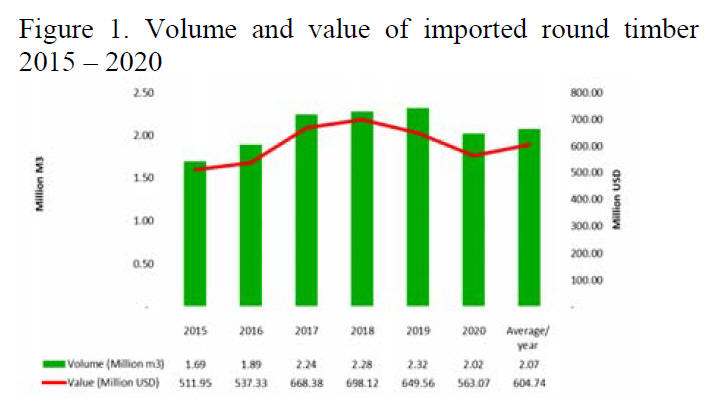
Main countries exporting round timber to
Viet Nam
Round timber is imported into Vietnam from more than
100 countries and territories. However, only few countries
have large volume of round timber exported to Viet Nam.
Table 1 below lists countries which are exporting large
volume of round timber to Vietnam. These countries share
about 65 – 70% of total import of round timber and are
classified into two categories, namely low-risk and highrisk
geographical areas.
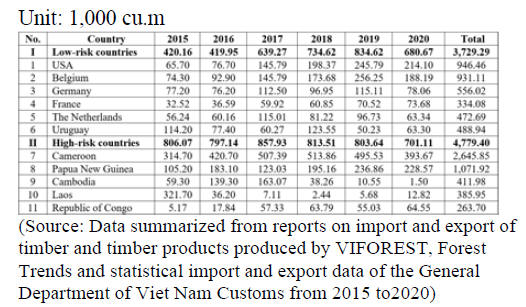
Countries of active or low-risk geographical areas
include
the US, Belgium, Germany, the Netherlands and Uruguay
etc. The US is the largest round timber exporter to Viet
Nam with an average of 157,000 cu.m per year and about
946,460 cu.m for in the whole 2015 – 2020 period.
Countries of non-active or high-risk geographical includes
Cameroon, Papua New Guinea, Cambodia, Laos and
Republic of Congo etc.
Cameroon is the largest round timber exporter to Vietnam
with an average of 0.4 – 0.5 million cu.m per year and 2.6
million cu.m for the whole period.
The volume of round timber imported from Laos and
Cambodia has sharply decreased over the investigated
period 2016 – 2020. In the recent past, before 2015, Laos
and Cambodia used to be largest exporters for Vietnam.
Figure 2. Proportion (%) of round timber imported into
Vietnam from major sourcing countries of high-risk
geographical areas 2015 - 2020
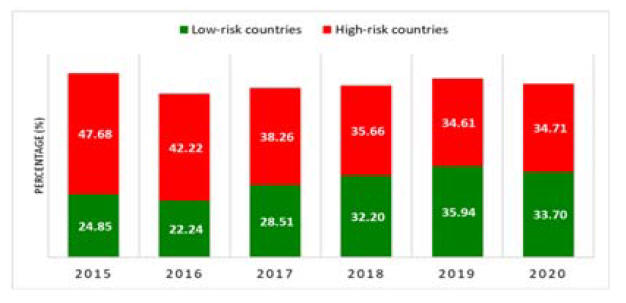
Table 1 and Figure 2 show that in 2015 the volume of
timber imported from major sourcing countries
categorized as high-risk geographical regions totaled
806,070 cu.m, nearly double the volume of timber
imported from low-risk geographical countries, accounting
for 47.68% of total round timber supplies of Viet Nam.
However, by 2020, the volume of timber imported from
high-risk geographical countries decreased to about
701,110 cu.m, accounting for 34,71% of total volume of
imported timber, while the volume of timber imported
from low-risk geographical countries increased to 680,670
cu.m, accounting for 33.7%.
The volume of round timber imported from USA and
Belgium has rapidly increased over the years.
The volume of round timber imported from USA alone
increased from 65,700 cu.m in 2015 to 214,100 cu.m in
2020. In contrast, the volume of round timber imported
from some countries such as Laos and Cambodia has
rapidly decreased as these countries have implemented
policies to restrict the export of round timber. The volume
of round timber imported from Laos decreased from
321,700 cu.m in 2015 to 12,820 cu.m in 2020, down 96%
compared to 2015.
Table 2 summarizes the value of round timber imported
from low-risk and high-risk geographical countries.
Cameroon, USA, Belgium, Papua New Guinea are leading
with respect to the value of round timber exported to Viet
Nam. Particularly, Cameroon has high export value with
an average of 150-200 million US$ per year, reaching over
1 million US$ during in the 2015 – 2020 period.
The value of timber imported from these countries’
accounts for 65-75% of total import value of round timber.
Moreover, in this period, the value of round timber
imported from low-risk geographical countries has
increased whereas the value of round timber imported
from high-risk geographical countries has decreased from
55.06% in 2015 to 38.41% in 2020 (Figure 3). This is
considered as a positive signal of the implementation of
VPA/FLEGT and policies to control and manage timber
imported into Viet Nam.
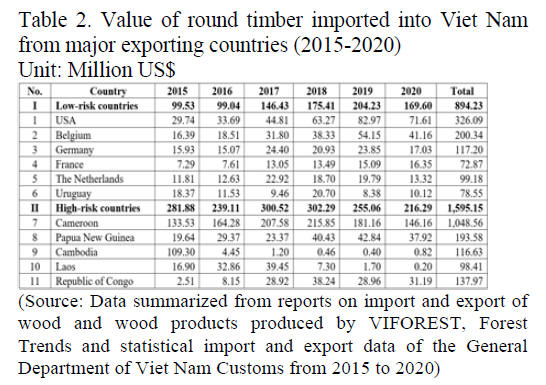
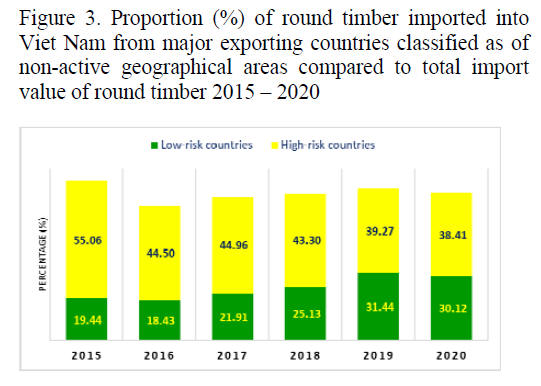
The current situation of imported sawn
timber
The import volume of sawn timber increased from 2.22
million cu.m in 2015 to 2.54 million cu.m in 2020 (the
annual average import volume is about 2.3 million cu.m).
However, the import value of sawn timber decreased from
1,147 million US$ in 2015 to 749.01 million US$ in 2016.
The average import value is about 912 million US$ with
minor fluctuations likely influenced by the decline of rare
and precious timber species imported from Laos and
Cambodia. The change in volume and value of imported
sawn timber is summarised in Figure 4 below.
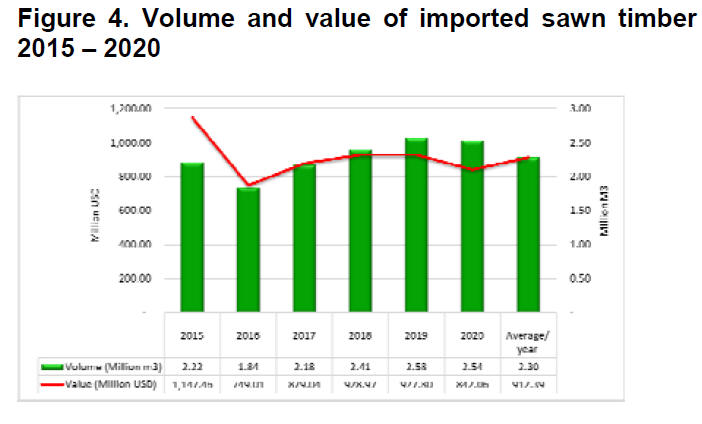
Major countries supplying sawn timber to
Viet Nam
Viet Nam imports sawn timber from various countries
including USA, Chile, Brazil, New Zealand, Cambodia
etc. (hereinafter referred to a “main supplier”). The US is
the largest supplier with volumes increasing from 474,000
cu.m in 2015 to 597,000 cu.m in 2020.
Between 2015 - 2020, the total volume of sawn timber
imported from the main suppliers account for 75-80% of
the total import volume of sawn timber, equivalent to
about 7.74 million cu.m.
As observed in Table 3, the volume of sawn timber
imported from low-risk suppliers has been increasing fast.
In 2015, the volume of sawn timber imported from the
main suppliers of low-risk and high-risk geographical
areas amounted to approximately 850,000 cu.m,
accounting for 38% and 40% for the low-risk and highrisk
categories.
However, these proportions have changed in recent years.
In 2020, the volume of sawn timber from main suppliers
of low-risk geographical areas increased by 1.53 million
cu.m, nearly double the import volume in 2015,
accounting for 68.99% of total import volume of sawn
timber.
Meanwhile, the volume of sawn timber imported from
main suppliers in high-risk geographical areas contributes
just 14.12% of total import volume of sawn timber in
2020.
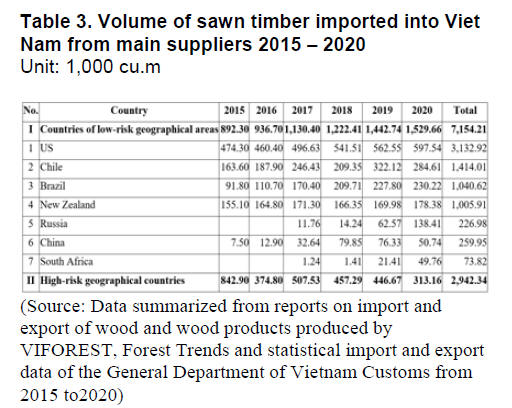
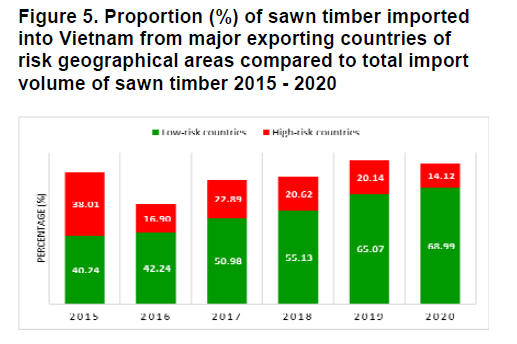
Table 4 presents the value of imported sawn timber
from
main suppliers which account for 75 - 85% of the total
import value of sawn timber. The import value of sawn
timber from the US amounts to 200 - 250 million US$ per
year. Of special attention is the decrease of import value of
sawn timber from Laos and Cambodia (e.g. from
Cambodia the value decreased from US$ 362 million in
2015 down to US$ 7.17 million in 2020).
The total import value of sawn timber from countries of
high-risk geographical areas significantly decreased from
655.9 million US$ in 2015 to around 150.4 million US$ in
2020.
Thus, as of 2020, the import value of sawn timber from
high-risk geographical areas accounted for just 17.86%,
while the import value of sawn timber from countries of
low-risk geographical areas (472 million US$) accounted
for 56.1% of total import value of timber in 2020.
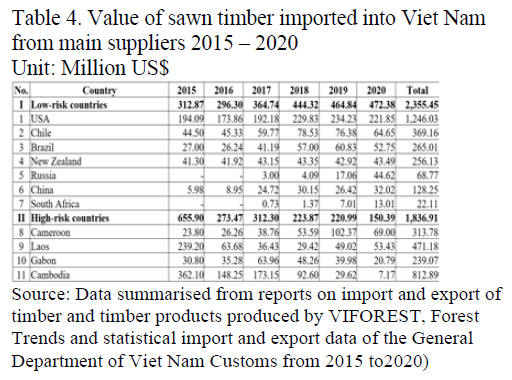

Promulgation and implementation of policies
on
managing imported timber to ensure timber legality
The regulatory framework applicable for timber legality
assurance covers the following legal documents:
Decision No. 1624/QĐ-TTg dated 14 November 2019 of
the Prime Minister to approve the plan for implementation
of the Voluntary Partnership Agreement between the
Socialist Republic of Viet Nam and the European Union
on Forest Law Enforcement, Governance and Trade
(VPA/FLEGT). This Decision specified tasks and
responsibilities of relevant agencies and organizations in
VPA/FLEGT implementation.
Decree No. 102/2020/NĐ-CP dated 1 September 2020 of
the Government to promulgate Vietnam Timber Legality
Assurance System (VNTLAS). The Decree has specified
the main contents of the VPA/FLEGT, including
management of imported timber and supply chain control
in the Vietnamese context. Accordingly, enterprises
importing timber into Viet Nam from high-risk
geographical areas are subject to due diligence practice
and submission of additional evidences to prove the
legality of imported timber.
Decision No. 4832/QĐ-BNN-TCLN dated 27 November
2020 of the Minister of Agriculture and Rural
Development to announce the list of timber species which
have been imported into Viet Nam and the list of countries
attributed to active/non-active geographical areas.
According to this Decision, the number of timber species
which have been entered Vietnam has been recorded 322
species and 51 countries have been classified as of active
or low-risk geographical areas. Those imported timber
species and timber exporting countries that are not listed in
this Decision will be considered as risk timber species and
countries of high-risk geographical areas.
Control and management of imported timber
Chart 1 outlines the procedure of imported timber control
and defined responsibilities of relevant stakeholders to
ensure timber legality requirements applicable for
imported timber.
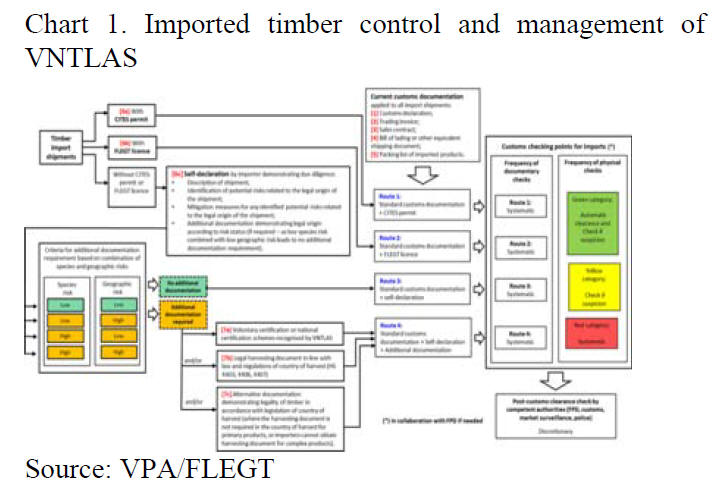
In addition to the existing legal framework to
regulate
timber imports, under VNTLAS new regulations have
been promulgated. For example, in accordance with the
Decree No. 102/2020/NĐ-CP specifying the operation of
VNTLAS, risk mitigation measures must be applied by
importers to prevent possible violation.
This Decree also aims to create favorable conditions for
operators to comply with relevant laws. Imported timber
is, therefore, controlled and managed in accordance with
criteria of active/non-active geographical areas with
low/high risk treatment. Importers must comply with
regulations on provision of dossiers, declaration of origin
of imported timber, and take responsibilities for the
accuracy of provided dossiers and declared information
(Clause 4, Article 4, Decree No. 102/2020/NĐ-CP).
Decree 102 assigned the Ministry of Agriculture and Rural
Development to collaborate with relevant agencies (the
General Department of Customs, Ministry of Industry and
Trade, Ministry of Natural Resources and Environment,
Ministry of Foreign Affairs) to define the list of countries
classified as of active geographical areas which are
exporting timber to Viet Nam in accordance with the
international treaties to which Viet Nam is a signatory.
The Decree also stipulates the responsibility of customs
authorities and forest protection agencies in management
of imported timber as well as verification of the legality of
each shipment of imported timber.
Success and challenges in timber legality control and
assurance
One of the most important benefits of the extant timber
legality system is the increase of imported timber from
low-risk countries in the 2015 – 2020 period.
This reduction is likely associated to the system’s
capability to support the adaptability and competitiveness
of the timber industry and institutionalizes the correct
regulations. These policies specified in the aforementioned
legal documents have reduced numerous administrative
procedures for enterprises to help improve the
effectiveness of control and management of imported
timber to meet the VNTLAS requirements.
Moreover, timber processing and trading enterprises have
actively sourced timber raw materials from low-risk
geographical regions while reducing volume and value of
timber imported from high-risk geographical regions.
Challenges
Some challenges remain with respect to the legality of
imported timber. First, the proportion of imported from
non-positive or high-risk geographical regions remains
high, accounting from 14% to 38.4% of total volume of
timber imported into Viet Nam, especially with respect to
imported round timber. Second, the standardization and
synchronization of the national.
TLASs in different countries are complex because these
systems are developed on the basis of independent
national legal systems. Lastly, many countries have not
developed legal regulations for the whole supply chain,
especially the supply chain in which timber is transported
or traded through middlemen.
Recommendations for managing imported timber to
ensure legality of timber
Further clarifying criteria of active geographical
areas/countries which are exporting timber to facilitate the
compliance with timber legality requirements.
The classification of countries/regions based on criteria
defined in Decree No. 102/2020/NĐ-CP and Decision No.
4832/QĐ-BNN-TCLN leads to limited number of low-risk
countries. The authors suggest that those countries that
have signed VPA, but have not reached the stage of
FLEGT licensing and or countries that have been
negotiating with EU to conclude VPA, can also be
considered as of low-risk.
Due diligence practice to avoid illegally sourced timber
along the entire supply chain is complex and resource
consuming. The authors recommend to simplify and due
diligence requirements and take due diligence
performance as a key criterion for imported timber control
under VNTLAS.
Regarding the criterion on national regulatory timber
certification scheme recognised by Viet Nam (under
VNTLAS requirements) there is often a lack of
information to verify the availability of national
timber/forest certification schemes.
The operators from sourcing countries should submit
accurate documents to validate the schemes applicable in
their countries.
Controlling and managing the compliance with legality
requirements applicable for timber imported into Viet
Nam
In accordance to VNTLAS, Viet Nam needs to strengthen
bilateral relations with low-risk countries to stabilize the
supply of imported timber and satisfy wood processing
demands for export.
The national legal framework for each risk geographical
category needs to be finalized in order to facilitate the
management of imported timber.
Strengthen the application of information and technology
for better sharing data between relevant agencies (e.g.
forest protection agencies and customs authorities),
facilitating one-door procedure processing, and optimizing
the fast clearance of import and export procedures.
To satisfy the VNTLAS requirements, enterprises
importing timber from risk markets need to comply with
additional due diligence requirement as specified in the
Decree No. 102/2020/NĐ-CP. Along with due diligence
practice, new market studies should be conducted to select
additional low-risk countries from where to import timber.
These studies should provide necessary evidences for
verification of legal timber origin.
Conclusion
Imported timber plays an important role in the
development of Vietnam’s wood processing industry. The
results of this study indicate positive signals for the growth
of volume and value of timber imports from low-risk
countries.
The authors argue that the national regulatory framework
supporting VNTLAS is key driver of these changes and
facilitating the implementation of the VPA/FLEGT.
Although the timber imported from high-risk geographical
areas is on decline, its share of annual import volume is
still high. Yet, there is a significant proportion of imported
timber coming from natural forests and meeting local
demand in housing and furnishing.
To assure the legal origin of timber Viet Nam needs to
adjust the criteria for categorisation of low-risk countries
and introduce mechanisms to effectively control and
manage the timber and application of information and
technology for the traceability of timber origin.
8. BRAZIL
Furniture production increases
According to Abimóvel (Brazilian Furniture Industry
Association) furniture consumption in March 2022 was
28.1 million pieces out of the 29.3 million pieces produced
and this represented an increase of almost 12% over the
previous month.
However, the accumulated consumption January to March
2022 was down 28% compared to the same period in 2021
when the furniture market was influenced by COVID-19
pandemic control measures. Brazilian furniture exports in
March amounted to US$71.6 million, a 4% growth over
the previous month. In April 2022, however, there was a
8% drop over March. In the first quarter of 2022 imports
of furniture manufacturing machinery dropped over 20%
year on year.
See:
https://forestnews.com.br/abimovel-consumo-de-moveisfoi-de-281-milhoes-de-pecas-em-marco/
Combating forest fires
The Ministry of Justice has announced that it will send a
task-force to combat forest fires and unauthorised burning
in Brazilian biomes.
This initiative is part of the’ Operations Guardians of the
Biome’ which will focus this year on regions of the
Amazon, Cerrado, Pantanal, Atlantic Forest and Caatinga
biomes including operations in 9 states of the Amazon
region (Acre, Amazonas, Amapá, Maranhão, Mato Grosso
do Sul, Mato Grosso, Pará, Rondônia, Roraima). The
estimated cost of the task-force is R$77 million.
More than 6,000 staff will work in the task-force including
representatives from the Chico Mendes Institute for
Biodiversity Conservation (ICMbio), the National Public
Security Force and the Brazilian Institute for the
Environment and Renewable Natural Resources
(IBAMA).
The security staff will monitor and implement actions in
places where there are large fire as well as investigate
crimes. The Federal Government expects that the task
force will continue until January 2023 when the critical
drought season should end.
The first phase of the ‘Operations Guardians of the Biome’
against forest fires and wildfires was launched in July
2021 and ended in late January 2022. According to the
government, during that period the professionals of the
task-force tackled 18,000 forest fires and reported 7,000
environmental crimes.
See:
https://forestnews.com.br/ministerio-da-justica-lanca-planode-combate-a-queimadas-florestais-no-brasil/
Brazil-Sweden collaboration to promote sustainability
Brazil and Sweden have established a cooperation
mechanism that can generate proposals for the
development of technologies applied to bio-products and
sustainable forest management. This was announced
during the 3rd Brazil-Sweden Innovation Week when the
Executive Committee of the Brazil-Sweden Working
Group on Innovative Industrial High Technology met.
During the event Brazilian bio-economy specialists visited
the Swedish Research Institute (RISE) to identify
convergence of interests in the development of
technologies for bio-products, bio-materials and SFM.
In November 2022 Swedish specialists will visit to be
briefed on infrastructure of bio-economy research and
innovation in Brazil.
According to the Ministry of Science, Technology and
Innovations (MCTI) the idea is to take advantage of the
knowledge and experience of each country. Brazilians
have experience with the use of biodiversity while Sweden
has extensive forestry skills.
Brazil is currently Sweden's largest trading partner in
Latin America. More than 200 Swedish companies operate
in Brazil generating 70,000 jobs and revenues of R$85
billion according to the Swedish Embassy in Brasilia.
See:
https://summitagro.estadao.com.br/noticias-docampo/brasil-e-suecia-vao-colaborar-em-projetos-desustentabilidade/
Furniture exports disappoint
Furniture exports from Rio Grande do Sul State, one of the
main furniture production clusters in the country, fell 4%
in the first five months of 2022 according to Movergs
(Association of Furniture Industries of the State of Rio
Grande do Sul).
Never-the-less, the performance of furniture sector in the
State remains well-above what was recorded in the same
period in 2020 and 2019 (about 81% and 40% higher,
respectively).
The United States, Chile, Peru, Uruguay, the United
Kingdom, Paraguay, Bolivia and Colombia are the main
export destinations but imports by Peru have fallen.
See:
https://forestnews.com.br/exportacoes-de-moveis-gauchoscaem-42-nos-primeiros-cinco-meses/
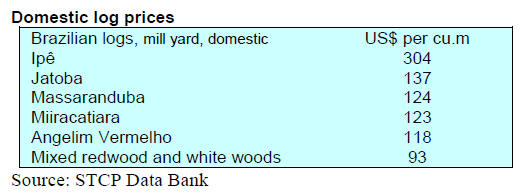
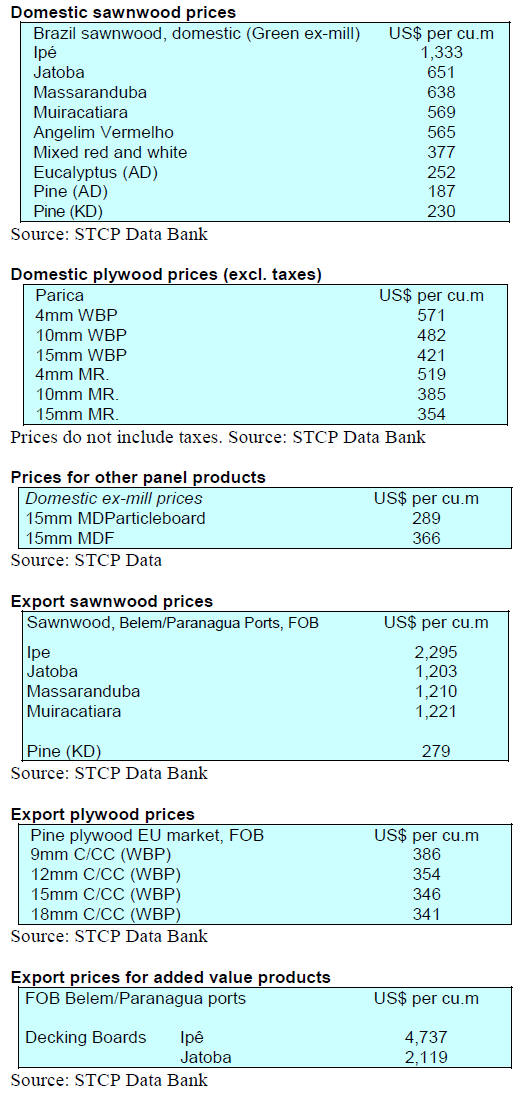
9. PERU
Rising shipments of manufactured
wood products
Exports of manufactured wood products in the first 4
months of the year totalled US$1.1 million, a growth of
140% compared to the same period in 2021 according to
the Extractive Industries Management of the Association
of Exporters (ADEX). This was the highest amount
between January and April over the past five years.
The increase is explained by higher demand from its two
main markets, the US (US$0.33 million) and the United
Arab Emirates (US$0.32 million), with increases of 49%
and 162%, respectively.
These two markets accounted for around 64% of the total.
Spain, Chile, Singapore, Belgium, Colombia, Panama,
France and Italy completed the list of top ten destinations.
The main items exported were chests and cases for jewelry
(US$0.53 million), statuettes and other adornments
(US$0.16 million), pallets, boxes and other cargo
platforms (US$0.12 million). ). The main exporting
regions for these products were Lima (US$0.97 million),
followed by Arequipa, Callao, Áncash and Piura.
These goods were shipped mainly through the Jorge
Chávez airport (US$0.58 million) and by sea (US$0.34
million) through the ports of Callao and Paita (Piura).
In 2021 shipments of manufactured wood products
reached US$1.4 million down 6% compared to 2020 and
down 21% compared to 2019. Last year they represented
just 1.1% of the total wood shipments. It should be noted
that it was in 2018 when these exports had their best
performance reaching US$2.8 million.
Initiatives on commercial forest plantations
The National Forest and Wildlife Service (Serfor) and the
World Bank have announced they will work together to
develop initiatives that promote reforestation and the
establishment of forest plantations.
The General Manager of Serfor, German Jaimes,
confirmed Serfor’s interest in working with the World
Bank on joint action to promote the reactivation of the
forestry sector.
He indicated that Serfor has a new management model that
has three very important pillars: the Forest Investment
Plan by 2050, the Quality and Integrity Management
System and the Investment Project of the National Forest
and Fauna Information System.
The Forest Investment Plan will optimise the
competitiveness of the forest, forest governance, forestry
and wildlife research and the efficient zoning of all the
departments of Peru.
Modifications to the ‘Operations Book provide to
Loreto
In order to improve the registration of information from
Primary Transformation Centers (CTP), the National
Forestry and Wildlife Service (SERFOR) and the Ministry
of Economy and Finance (MEF) have presented a proposal
to modify the so-called ‘Operations Book’ to the forestry
authorities of Loreto.
The proposal has ben prepared with the technical
assistance from USAID Pro-Bosques and modifies the
format in order to improve the way improving transpareny
in traceability of forest products.
According to SERFOR the main contribution in the
proposal is to link the sawnwood with the log’s of origin.
This proposal will allow better traceability and record
much more real information.
After the tests, the regional forestry authorities of Loreto,
Ucayali and Madre de Dios, where this proposal is
presented, will monitor and accompany the sawmills to
obtain the results of this pilot, which will be presented to
SERFOR for approval. Trials will be conducted before it
is introduced.
Exports from Amazon areas
Exports from the Amazonregions (Amazonas, Loreto,
Madre de Dios, San Martín and Ucayali) totalled more
than US$221.1 million between January and April of this
year an increase of 58% compared to the same period in
2021 according to ADEX. This was the highest in recent
years.
According to the ADEX Data Trade Commercial
Intelligence System traditional shipments (US$117.8
million) increased 52% and accounted for 53% of the total
due to the large shipments of hydrocarbons (+31%).
Others were mining (61%) and agriculture (100%).
Added value product exports were value at US$103.2
million and included agricultural products (US$78.6
million) followed by wood (US$23.1 million).
The main market for Amazon products was Brazil with
US$47.3 million. Other markets were India, Mexico, the
US and the Netherlands.
The Madre de Dios region ranked first and exports were of
raw gold, Brazil nuts, molded wood, slats and friezes for
parquet flooring and tropical sawnwood.
